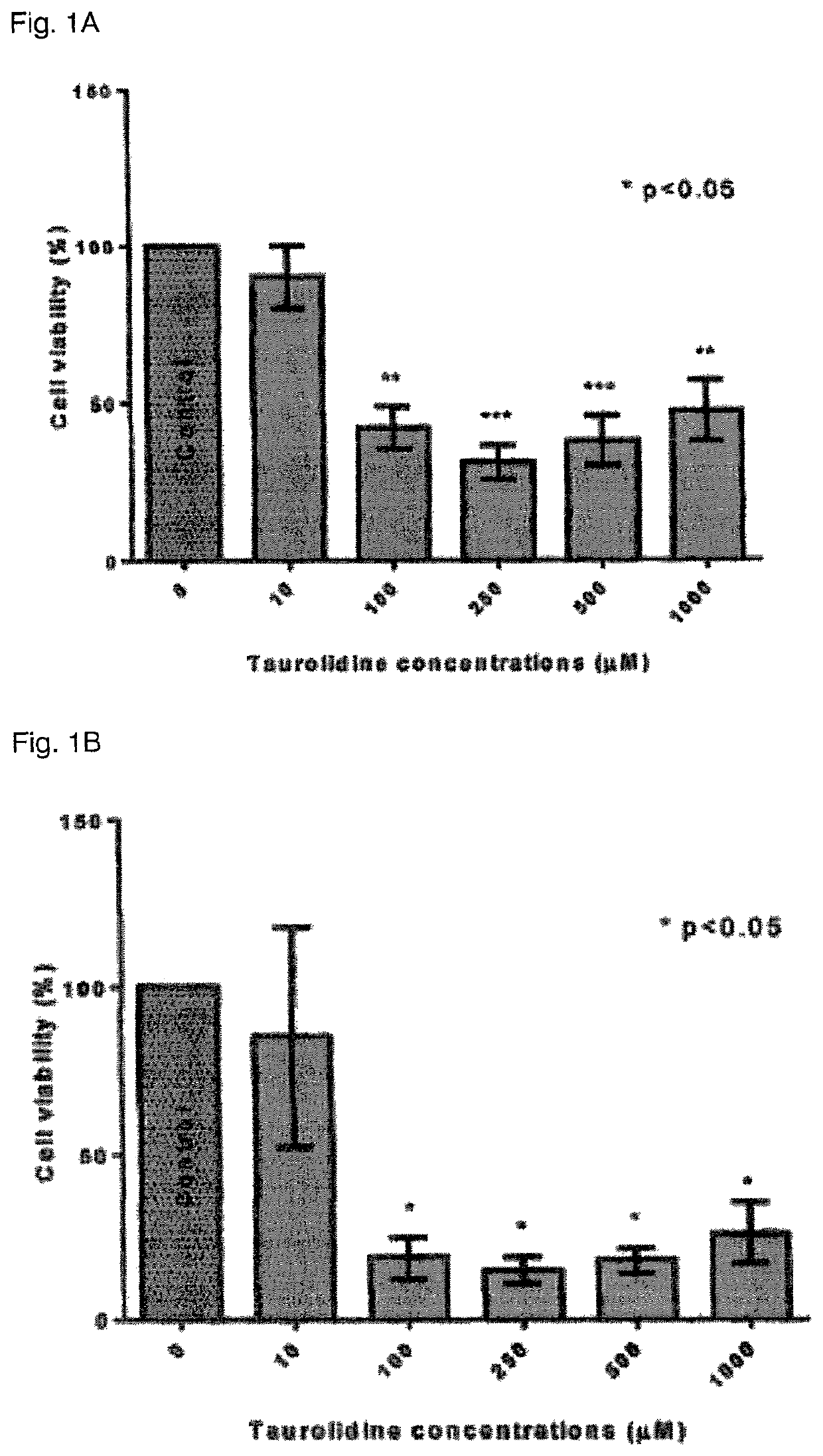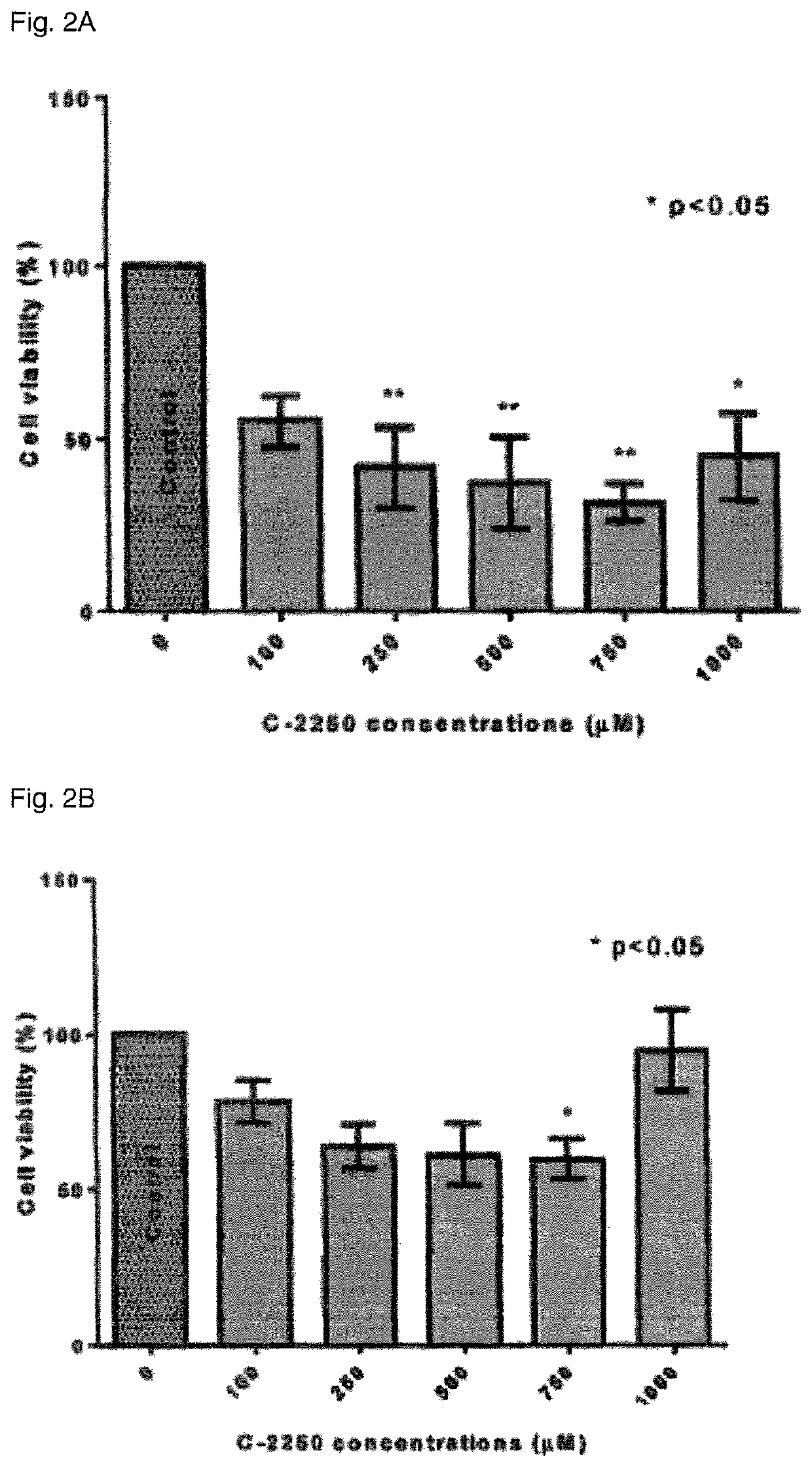Method of treating triple negative breast cancer
a breast cancer and triple negative technology, applied in the field of triple negative breast cancer treatment, can solve the problems of tnbc being difficult to treat, affecting and reducing the survival rate of patients with triple negative breast cancer, so as to achieve the effect of safe, tolerable and safe long-term use of tnb
- Summary
- Abstract
- Description
- Claims
- Application Information
AI Technical Summary
Benefits of technology
Problems solved by technology
Method used
Image
Examples
example 1
ncer Cell Viability Studies
Introduction
[0182]Based on the recognition of taurolidine and C-2250 as powerful anti-neoplastic agents, these agents were tested against the following breast cancer cell lines: BT-20 (primary breast cancer, HR negative), MDA-MB-231 (metastatic, HR negative) and MCF-7 (metastatic, HR positive). BT-20 and MDA-MB-231 are TNBC cell lines, whereas MCF-7 is not a TNBC cell line.
Material and Methods
[0183]The BT-20 cell lines were cultured in EMEM supplemented with 10% fetal bovine serum (FBS) and 1% penicillin-streptomycin (pen-strep). The MCF-7 was cultured in DMEM, supplemented with 10% FBS, 1% pen-strep and 0.1% Insulin. The MDA-MB-231 was cultured in DMEM with 10% FBS and 1% pen-strep. All cells were cultured at 37° C. in a humidified atmosphere with 5% CO2.
[0184]Chemicals: Taurolidine 2% solution and C-2250 ultra-pure powder were provided by Geistlich Pharma AG, Wolhusen, assignee of the present invention. The C-2250 solution was prepared by dissolving it i...
example 2
atment Case Study
Patient Diagnosis and History Before Study:
[0195]September of Year 1: A fifty year old Caucasian female with histological diagnosis of triple negative breast cancer of the right breast 3 cm G3, CS axilla (histologically G3 with medullary shares, ER, PR and Her 2-new negative). Disseminated lung metastasis.
[0196]Ki-67: 61% indicative of very high breast cancer cell division.
[0197]Additional evidence of ductal carcinoma in situ (DCIS) with focal vascular invasion; BRCA1 neg.
[0198]Before entering the study, the patient had been treated with numerous oncology and chemotherapy treatments including weekly neoadjuvant Taxol chemotherapy, lumpectomy with wide local excision, and adjuvant radiotherapy of the right chest wall. These treatments were ineffective and the patient developed metastatic dissemination and neutropenia, and was an end-stage (stage IV) patient.
Study Protocol:
[0199]Patient began the study having a Karnofsky score of 80%, mild neuropathy with distal empha...
example 3
ncer Cell Line Potencies
[0213]Methods: Primary and metastatic ER negative breast cancer cells (BT-20 and MDA-MB-231) and ER positive cells (BT-474 and MCF-7) were separately treated with increasing concentrations of Taurolidine and 2250 as shown in FIG. 7A and FIG. 8A. Apoptosis and necrosis were evaluated based on phosphatidylserine externalization using annexin V and propidium iodide (PI). The contribution of caspases 3, 8 and 9 on apoptosis, and autophagy was evaluated by both flow cytometry and western blotting. The impact of reactive oxygen species (ROS) was evaluated using the radical scavenger agent n-acetylcysteine (NAC) and buthionine-sulfoximine (BSO), a glutathione-depleting agent. Necroptosis was evaluated using nescrostatin-1, a potent inhibitor of the process.
[0214]Results: Dose-dependent increases in cell death were observed in ER-positive and ER-negative breast cancer cells treated separately with Taurolidine and 2250. A concentration of ≥100 μM (≥284.7 microgram) of...
PUM
| Property | Measurement | Unit |
|---|---|---|
| temperature | aaaaa | aaaaa |
| temperature | aaaaa | aaaaa |
| temperature | aaaaa | aaaaa |
Abstract
Description
Claims
Application Information
 Login to View More
Login to View More - R&D
- Intellectual Property
- Life Sciences
- Materials
- Tech Scout
- Unparalleled Data Quality
- Higher Quality Content
- 60% Fewer Hallucinations
Browse by: Latest US Patents, China's latest patents, Technical Efficacy Thesaurus, Application Domain, Technology Topic, Popular Technical Reports.
© 2025 PatSnap. All rights reserved.Legal|Privacy policy|Modern Slavery Act Transparency Statement|Sitemap|About US| Contact US: help@patsnap.com



